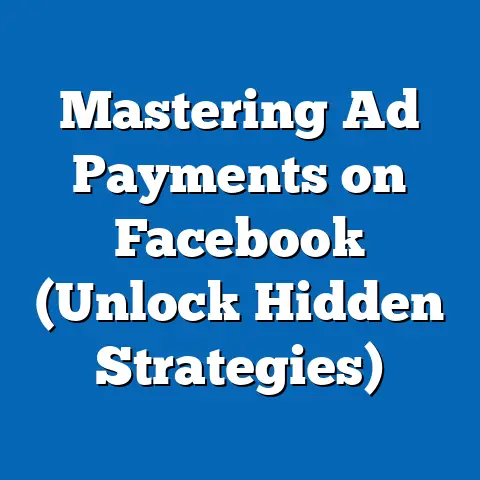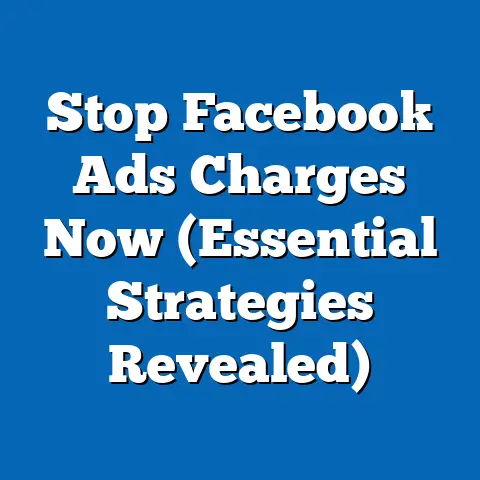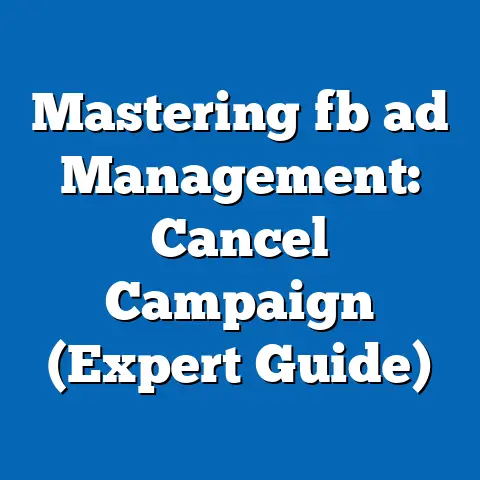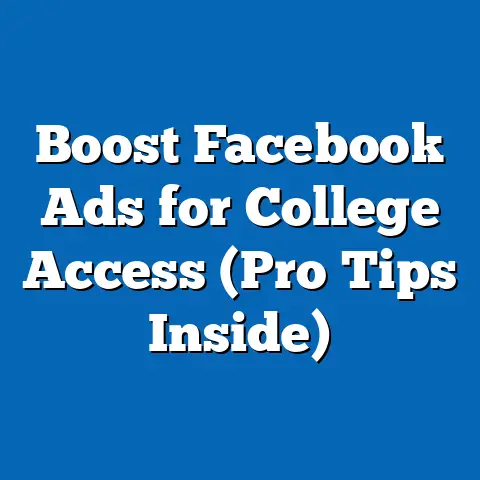Add Advertisers on Facebook (Pro Tips for Success)
I’ve been immersed in the world of Facebook advertising for over a decade, witnessing firsthand its incredible evolution and the ever-changing landscape of digital marketing. One thing that has remained constant is the power of visual appeal. A beautifully crafted ad can stop a scroller in their tracks, while a poorly designed one will be instantly dismissed. In this guide, I want to share my insights on how to add advertisers to your Facebook account effectively, focusing on how their expertise can amplify your ad campaigns, especially when it comes to creating visually stunning and engaging content.
Aesthetics aren’t just about making things look pretty. They are about creating a connection, evoking emotion, and ultimately driving action. Think of it as the storefront of your digital business – you want it to be inviting, informative, and reflective of your brand’s personality. With over 2.9 billion monthly active users on Facebook, your potential audience is massive. But to capture their attention, you need ads that not only speak to their needs but also visually captivate them. Let’s dive deep into how you can leverage the expertise of advertisers to achieve just that.
Understanding Facebook Advertising
Facebook advertising is, in essence, a powerful tool that allows businesses to reach a highly targeted audience with personalized messages. Unlike traditional advertising methods, Facebook provides granular control over who sees your ads, based on factors like demographics, interests, behaviors, and even connections. This level of precision allows you to tailor your message to resonate with specific segments of your audience, maximizing the impact of your advertising spend.
Over the years, Facebook has transformed from a simple social network into a sophisticated advertising platform. Early on, the focus was primarily on reach and basic demographics. Today, the platform offers a wide array of ad formats, targeting options, and optimization tools. From simple image ads to interactive video ads and lead generation forms, the possibilities are virtually endless. This constant evolution requires advertisers to stay on top of the latest trends and best practices to remain competitive.
Consider these key statistics that highlight the importance of Facebook advertising:
- Reach: Facebook reaches over 2.9 billion monthly active users, making it one of the largest advertising platforms in the world.
- Targeting: Facebook’s advanced targeting options allow advertisers to reach specific demographics, interests, and behaviors.
- Engagement: The average Facebook user spends approximately 34 minutes per day on the platform, providing ample opportunities for ad exposure.
- ROI: Businesses report an average return on ad spend (ROAS) of $4.37 for every $1 spent on Facebook advertising.
Adding advertisers to your Facebook account is a strategic move that can significantly enhance ad performance. These individuals or agencies bring specialized skills and knowledge to the table, such as creative design, copywriting, audience targeting, and data analysis. By delegating these tasks to experienced professionals, you can focus on other aspects of your business while ensuring that your ad campaigns are in capable hands.
Key Takeaway: Facebook advertising offers unparalleled reach and targeting capabilities. Adding skilled advertisers to your account can amplify your results and ensure that your campaigns are optimized for success.
The Aesthetic Appeal of Facebook Ads
Aesthetics play a pivotal role in the success of Facebook ads. In a world inundated with information, visually appealing ads are more likely to capture attention, convey your message effectively, and drive engagement. Think of your own browsing experience – what makes you stop scrolling? It’s often the visual element that first grabs your eye.
Several elements contribute to the aesthetic appeal of Facebook ads:
- Color Theory: Colors evoke emotions and associations. Understanding color psychology can help you choose colors that resonate with your target audience. For example, blue often conveys trust and reliability, while red can signal excitement and urgency.
- Typography: The fonts you use in your ads can impact readability and brand perception. Choose fonts that are legible, align with your brand’s personality, and complement your visual elements.
- Imagery: High-quality images and videos are essential for capturing attention. Use visuals that are relevant, engaging, and representative of your brand. Consider using professional photography or videography to ensure a polished look.
- Layout and Composition: The way you arrange elements within your ad can impact how viewers perceive your message. Use a clear and uncluttered layout that guides the eye and highlights key information.
- Branding: Consistent branding is crucial for building brand recognition and trust. Use your brand colors, logo, and visual style consistently across all your ads.
Let’s look at some examples of successful ads that utilize strong aesthetic principles:
- Nike: Nike often uses powerful imagery of athletes in action, combined with minimalist text and their iconic swoosh logo. Their ads evoke a sense of athleticism, determination, and inspiration.
- Airbnb: Airbnb’s ads often feature stunning photographs of unique accommodations around the world. These visuals inspire wanderlust and showcase the unique experiences that Airbnb offers.
- Apple: Apple’s ads are known for their sleek, minimalist design and focus on showcasing the product’s features. Their visuals are clean, modern, and emphasize simplicity.
Color psychology is a powerful tool in advertising. Different colors can evoke specific emotions and associations, influencing how viewers perceive your brand and message. Here are a few examples:
- Blue: Trust, reliability, calmness
- Red: Excitement, urgency, passion
- Green: Health, nature, growth
- Yellow: Optimism, happiness, energy
- Purple: Luxury, creativity, wisdom
Consistent branding is essential for building brand recognition and trust. When your ads consistently use your brand colors, logo, and visual style, viewers are more likely to recognize and remember your brand. This can lead to increased brand awareness, customer loyalty, and ultimately, sales.
Key Takeaway: Aesthetics are crucial for capturing attention and conveying your message effectively. Understanding color theory, typography, imagery, and consistent branding can help you create visually appealing ads that resonate with your target audience.
How to Add Advertisers on Facebook
Adding advertisers to your Facebook Ads account is a straightforward process, but it’s important to understand the different roles and permissions available to ensure a smooth and secure collaboration. Here’s a step-by-step guide:
- Go to Facebook Business Manager: Log in to your Facebook Business Manager account. If you don’t have one, you’ll need to create one.
- Navigate to Business Settings: In the Business Manager dashboard, click on “Business Settings” in the left-hand menu.
- Select “People”: In the “Users” section, click on “People.”
- Click “Add”: Click the blue “Add” button to add a new person to your Business Manager.
- Enter Email Address: Enter the email address of the person you want to add as an advertiser.
- Assign Role: Choose the appropriate role for the advertiser. You have two main options:
- Employee Access: This role allows the person to work on your Business Manager account but doesn’t grant them full admin control.
- Admin Access: This role grants the person full control over your Business Manager account, including the ability to add or remove people, manage settings, and access all features. Be cautious when granting admin access, as it gives the person significant power over your account.
- Assign Assets: After assigning a role, you’ll need to assign specific assets to the advertiser, such as your ad account and Facebook Page. Click on each asset and choose the appropriate permissions. For an ad account, you can grant permissions such as:
- Manage Campaigns: Allows the advertiser to create, edit, and manage ad campaigns.
- View Performance: Allows the advertiser to view ad performance data.
- Manage Ad Account: Allows the advertiser to manage the ad account settings and billing information.
- Send Invitation: Once you’ve assigned the role and assets, click “Invite” to send an invitation to the person. They will receive an email with instructions on how to accept the invitation and access your Business Manager account.
- Employee Access: This role allows the person to work on your Business Manager account but doesn’t grant them full admin control.
- Admin Access: This role grants the person full control over your Business Manager account, including the ability to add or remove people, manage settings, and access all features. Be cautious when granting admin access, as it gives the person significant power over your account.
- Manage Campaigns: Allows the advertiser to create, edit, and manage ad campaigns.
- View Performance: Allows the advertiser to view ad performance data.
- Manage Ad Account: Allows the advertiser to manage the ad account settings and billing information.
When selecting advertisers, consider the following factors:
- Expertise: Look for advertisers with a proven track record of success in your industry or niche.
- Experience: Choose advertisers with experience in creating visually appealing and engaging ads.
- Portfolio: Review their portfolio to assess the quality of their work and their ability to create ads that align with your brand’s aesthetic.
- Communication Skills: Effective communication is essential for a successful collaboration. Choose advertisers who are responsive, proactive, and able to clearly articulate their ideas and strategies.
- Alignment with Brand Goals: Ensure that the advertiser’s goals and values align with your own. This will help ensure that they are committed to achieving your business objectives.
Here are some common mistakes to avoid when adding advertisers:
- Granting Excessive Permissions: Avoid granting admin access unless it’s absolutely necessary. Start with employee access and grant additional permissions as needed.
- Failing to Assign Assets: Make sure to assign the appropriate assets to the advertiser, such as your ad account and Facebook Page. Without access to these assets, they won’t be able to manage your ad campaigns.
- Not Setting Clear Expectations: Clearly communicate your goals, expectations, and aesthetic preferences to the advertiser. This will help ensure that they are on the same page and can deliver results that meet your needs.
- Skipping the Onboarding Process: Take the time to properly onboard the advertiser to your Business Manager account and familiarize them with your brand, target audience, and advertising goals.
Key Takeaway: Adding advertisers to your Facebook Ads account is a straightforward process. Assign the appropriate roles and permissions, select advertisers with relevant expertise, and avoid common mistakes to ensure a smooth and successful collaboration.
Collaborating with Advertisers for Better Results
Collaboration is the cornerstone of successful Facebook advertising campaigns. When businesses and advertisers work together effectively, they can leverage their respective strengths to create visually appealing ads that resonate with their target audience and drive results.
Here are some strategies for effective collaboration:
- Establish Clear Communication Channels: Set up regular check-ins, meetings, or online communication channels to facilitate open and transparent communication.
- Define Roles and Responsibilities: Clearly define the roles and responsibilities of each party involved in the advertising process. This will help avoid confusion and ensure that everyone is working towards the same goals.
- Set Clear Goals and Expectations: Clearly communicate your goals, expectations, and aesthetic preferences to the advertiser. This will help ensure that they are on the same page and can deliver results that meet your needs.
- Provide Regular Feedback: Provide regular feedback on the advertiser’s work, both positive and constructive. This will help them understand your preferences and improve their performance over time.
- Use Collaborative Tools: Utilize collaborative tools such as project management software, shared documents, and communication platforms to streamline the advertising process.
Here are some success stories of businesses that have successfully partnered with advertisers:
- Example 1: A local restaurant partnered with a digital marketing agency to create visually appealing Facebook ads that showcased their menu items and ambiance. The agency used professional photography and videography to create mouthwatering visuals that captured the attention of local foodies. As a result, the restaurant saw a 30% increase in foot traffic and online orders.
- Example 2: An e-commerce store partnered with a freelance graphic designer to create eye-catching Facebook ads that highlighted their latest products and promotions. The designer used vibrant colors, engaging typography, and compelling visuals to create ads that stood out in the crowded newsfeed. As a result, the e-commerce store saw a 25% increase in website traffic and sales.
- Example 3: A non-profit organization partnered with a social media marketing consultant to create emotionally resonant Facebook ads that raised awareness for their cause. The consultant used storytelling techniques and powerful imagery to connect with viewers on an emotional level. As a result, the non-profit organization saw a 40% increase in donations and volunteer sign-ups.
Aligning on creative vision and aesthetic preferences is crucial for ensuring cohesive ad campaigns. Before embarking on a new advertising project, take the time to discuss your brand’s visual identity, target audience, and advertising goals with the advertiser. Share examples of ads that you find visually appealing and explain why. This will help the advertiser understand your preferences and create ads that align with your brand’s aesthetic.
Key Takeaway: Collaboration is essential for successful Facebook advertising campaigns. Establish clear communication channels, define roles and responsibilities, set clear goals and expectations, provide regular feedback, and align on creative vision to ensure cohesive ad campaigns that resonate with your target audience.
Measuring Success and Adjusting Strategies
In the ever-evolving world of Facebook advertising, measuring success and adjusting strategies are paramount to achieving your desired outcomes. It’s not enough to simply launch a campaign and hope for the best. You need to continuously monitor your ad performance, analyze the data, and make adjustments as needed to optimize your results.
Here are some key performance indicators (KPIs) to track:
- Reach: The number of unique people who saw your ad.
- Impressions: The number of times your ad was displayed.
- Click-Through Rate (CTR): The percentage of people who clicked on your ad after seeing it.
- Conversion Rate: The percentage of people who completed a desired action (e.g., making a purchase, filling out a form) after clicking on your ad.
- Cost Per Click (CPC): The average cost you pay each time someone clicks on your ad.
- Cost Per Acquisition (CPA): The average cost you pay to acquire a new customer or lead through your ad campaign.
- Return on Ad Spend (ROAS): The amount of revenue you generate for every dollar you spend on advertising.
Facebook Ads Manager provides a wealth of data and analytics that can help you monitor your ad performance. Within Ads Manager, you can track key metrics, view reports, and analyze trends to gain insights into your audience, ad creative, and overall campaign performance.
Here’s how to interpret data and adjust strategies accordingly:
- Identify Trends: Look for patterns and trends in your data. Are certain demographics more likely to click on your ads? Are certain ad creatives performing better than others?
- Analyze Performance: Compare your ad performance to industry benchmarks and your own historical data. Are you meeting your goals for reach, engagement, and conversions?
- Test and Iterate: Experiment with different ad creatives, targeting options, and bidding strategies to see what works best for your audience.
- Optimize for Conversions: Focus on optimizing your ads for conversions. This means creating ads that are relevant, engaging, and persuasive, and that lead to a clear call to action.
A/B testing is a powerful tool for optimizing ad aesthetics and overall performance. By testing different versions of your ads, you can determine which elements resonate best with your target audience. Here are some elements you can A/B test:
- Headlines: Test different headlines to see which ones capture attention and drive clicks.
- Images: Test different images to see which ones are most visually appealing and relevant to your target audience.
- Call to Actions: Test different call to actions to see which ones are most persuasive and effective at driving conversions.
- Ad Copy: Test different ad copy to see which ones resonate most with your target audience and communicate your message effectively.
- Targeting Options: Test different targeting options to see which ones are most effective at reaching your ideal customer.
Key Takeaway: Measuring success and adjusting strategies are crucial for optimizing your Facebook advertising campaigns. Track key performance indicators, analyze data, test and iterate, and use A/B testing to optimize your ad aesthetics and overall performance.
Conclusion
In conclusion, Facebook advertising offers a powerful platform for businesses to reach a highly targeted audience and achieve their marketing goals. However, success on Facebook requires more than just launching a campaign and hoping for the best. It requires a strategic approach that encompasses a deep understanding of aesthetics, effective collaboration with advertisers, and a commitment to continuous monitoring and optimization.
Throughout this guide, I’ve shared my insights on how to add advertisers to your Facebook account effectively, focusing on how their expertise can amplify your ad campaigns, especially when it comes to creating visually stunning and engaging content. I’ve emphasized the importance of aesthetics in capturing attention, conveying your message effectively, and driving engagement. I’ve also highlighted the value of collaboration between businesses and advertisers, and the need for clear communication, defined roles, and aligned goals. Finally, I’ve stressed the importance of measuring success, analyzing data, and adjusting strategies to optimize your results.
Now, it’s time to take action. Implement the tips and strategies shared throughout this guide to enhance your Facebook advertising campaigns. Add skilled advertisers to your account, focus on creating visually appealing ads, foster collaboration, and continuously monitor and optimize your performance.
Facebook advertising holds immense potential for businesses that are willing to invest the time and effort to do it right. By combining strong aesthetic principles with strategic partnerships and a data-driven approach, you can unlock the full potential of Facebook advertising and achieve your marketing goals. So, go forth and create visually stunning, engaging, and effective Facebook ads that captivate your audience and drive results!






